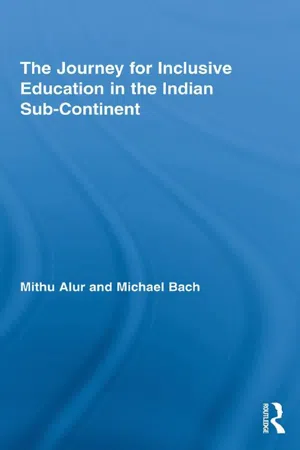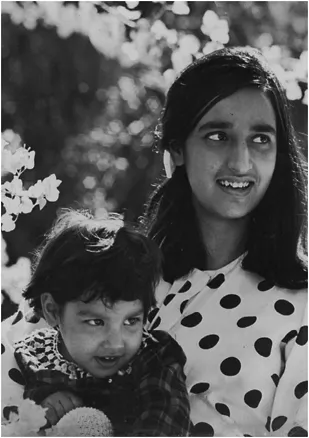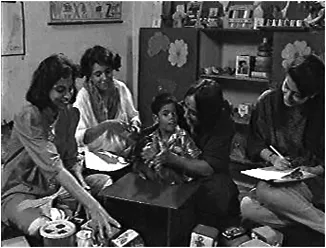![]()
Part I
Building a Movement for Inclusion
![]()
1
Sowing the Seeds of a Movement for Education of Children with Disabilities 1972–1993
‘The damage is irreversible. There’s nothing you can do about it.’
THE BIRTH OF A MOVEMENT
1966, Kolkata, India. I was twenty-three and my husband was twenty-five when our daughter Malini was born with cerebral palsy. Neither my husband nor I had any idea of what cerebral palsy was. While trying to get a correct diagnosis from India’s premier medical institute, in front of a group of young interns staring at me and our weeping daughter Malini, I was brusquely told:
The words ‘there’s nothing you can do about it’ rang in my ears over and over again … and I was determined not to accept that. My husband and I ran from pillar to post in search of a proper diagnosis. We looked for services all over India, but found none that were adequate for our child’s needs. It was a time when very little was known in India about the educational needs of children with cerebral palsy. Children with cerebral palsy were either left in hospitals or kept at home with no access to any services whatsoever. It was a very difficult time. Determined that our daughter would not be held back by the negative attitudes and lack of services in India, we decided to go to England in search of treatment for Malini. We had family in England; my sister and brother-in-law were working there at that time, both he and my husband had graduated from Cambridge. It was felt that facilities were going to be far better and superior in England, so it was resolved that we would move to Cambridge. Fortunately for us we had the contacts. It was a sad day when we sold and gave away many of our household items, packed up our home, and left for England.
For me, the time in England was key; it shaped my thinking and strengthened my resolve. In England I came to the realization, that if I was to create a promising future for my child I would need to prepare myself and learn everything possible about the condition of cerebral palsy. I was greatly encouraged by my husband to study. In 1970, I enrolled in a program to become a special educator, at the Institute of Education, University of London. Reading about the condition of cerebral palsy, studying, and discussing the implications with professors and my peers helped me to understand a very serious condition that was going to affect my daughter through her entire life. I met people who treated me and my daughter with great care and great sensitivity. This, combined with the knowledge I gained in my studies, helped me to face what was going to be an overwhelming and daunting challenge ahead. It had become clear to me through my early experience in India, and my studies and opportunities in England, that we had huge battles ahead of us still to fight. There was so much that needed to change.
In 1972 my husband and I returned to India,1 I found that in the six years we were away nothing had changed. There were still no schools for children with cerebral palsy. It was not even included in the Government’s Ministry of Welfare’s (the sole Ministry responsible for children with disabilities in India) classifications on the basis of which funds were allocated to various services throughout the country. It was then that that I resolved to create for India’s children with disabilities the same levels of care and stimulus that Malini had received in England. Again I was fortunate to have good contacts. So the organization began, as things usually do in India, at the top. Many friends came forward to help.2 A friend arranged for me to meet Indira Gandhi, then Prime Minister of India. At a private meeting with the Prime Minister I showed her a few slides of my daughter. She asked her name, how old she was. She became very interested in what had happened to Malini; she asked what cerebral palsy was. She reacted in a very humane way, and was interested in what Malini was doing now that we were back from England. I told her that she could read, she knew her numbers, and she had done well in school in England, but we had found to our shock that there was no school for her to attend once back in India. As one mother to another, she reached out and told me that if there was anything I thought she could do, she wanted me to let her know. I told Mrs. Gandhi that I would be in touch with her, and that for now I only needed her blessings. This was to be the first of many meetings with Mrs. Indira Gandhi.
Meanwhile she was very kind and recommended the names of twelve eminent citizens of Mumbai who could help me. Amongst the names were two famous actors and active workers for the country, the late Mrs. Nargis Dutt and the late Mr. Sunil Dutt. Mrs. Dutt became the first Patron of the Society, a very active one, and after her death Mr. Sunil Dutt took up the mantle. Both were members of the Rajya Sabha (the Upper House) and served our Society till their demise.
I wrote to Mrs. Gandhi immediately after our meeting thanking her for her concern and for sparing the time to see me. Eight months later I wrote again to tell her that I had raised Rs. 82,000 (now Rs. 42 equivalent to 1 US Dollar) to open and operate a school but we had no premises, I asked for her help.
The Prime Minister responded. She wrote to the Chief Minister of Maharashtra State requesting his assistance in helping us find a suitable place for our school. As a result of his interventions, the Indian Army offered us a ramshackle but beautiful bungalow on Ministry of Defence territory, in the Colaba region of Mumbai. Overlooking the Arabian Sea, it was an idyllic setting for our organization. It was originally built as a recreation centre for British soldiers in 1944. Finally we had a base from which we could begin. When we inherited the building, it was in a complete state of disrepair, with bandicoots, pigeons, rats, and stray dogs its only tenants for many years! Acquiring and renovating the physical space for the school was one step. Simultaneously we had to create an organization that would deliver the services. Together with my husband, and a few other parents and colleagues, we set up and formalized an organization called The Spastics Society of India (hereinafter referred to as SSI) in Mumbai. We envisaged it as a social and educational model for children with cerebral palsy, combining education and treatment under one roof. The main aim of the organisation was to alert the nation to their needs and to demonstrate how government and the community could set up services to fulfill their needs. We immediately began organizing events to raise funds—concerts, gala balls, art and craft exhibitions. Within a year we had raised the funds and completed the renovations.
Shortly thereafter, we opened our first school, ‘The Centre for Special Education,’ the first special school for children with cerebral palsy in India. How fitting that The Spastics Society of India, was officially inaugurated on the October 2, 1972, Mahatma Gandhi’s birthday! When the Colaba School opened in 1973 we began with assessment, infant stimulation and early intervention, and primary schooling. Over the years, as our first students grew into youth and adulthood we expanded the services into vocational training and a continuum of support services to assist adults with cerebral palsy in higher education and beyond. As the demand for our services grew beyond our capacity, we reached out to create home support services, training manpower, and expanding our capacity to help the rest of the country. Our fundraising efforts grew over the years as the Government of India, the corporate sector and international agencies became interested in our work.3
As I look back on our thirty-five years development, there seem to be three distinct periods of growth and transformation:
1. the creation and consolidation of services at Colaba School where we first put into practice our holistic approach to education, treatment and support;
2. expanding the reach of special education and services in Mumbai and beyond; and
3. the transformation from a special education approach to inclusive education and a focus on policy change.
In this chapter we review our first two phases of development; in Chapters 2 and 3 we examine the factors and stages in our transformation to inclusive education and a focus on policy change.
The Spastics Society of India—The School in Colaba by the Arabian Sea
My most profound learning as I began my journey and studies in education was how critical it was for children to be diagnosed as early as possible to prevent secondary and tertiary handicap from developing. Recalling the tortuous clinical examination to which Malini had been subjected to in hospitals in India, I decided that one of the first areas that the new organisation should develop was a ‘caring approach to assessment and therapy.’ The first services to be set up were for assessment, infant stimulation, home support and therapies. With these in place, and as children began to get the developmental supports they needed, our organization and services grew with them. We developed professional training for teachers and therapists,
education programs for school-age children, support for higher education, and vocational services as students transitioned to adulthood.
Realizing the importance of early identification and assessment, clinics were set up for babies at risk and those with developmental delays. Pediatricians and neurologists referred parents to our services for treatment of their child and for counseling parents and families. Infant Stimulation Clinics catered to children less than three years of age while a Home Management Program was set up admitting students from three years onwards. Individual as well as group sessions were conducted with parents in the Infant Stimulation Clinics; training enabled them to carry on the daily management of their child effectively at home, to achieve the desired progress. Programs were designed to aim at the motor, the cognitive and social development of the children thereby preparing them for entry into pre-school and primary school. Activities of daily living, included but not limited to how to feed your child; how to carry your child; how to introduce language if your child is nonverbal bearing in mind that she/he may not be speaking but can understand others, were introduced to the parents. Bearing this in mind, mothers were encouraged to be better educated about their babies and advised to work closely with the team at school. This was another new approach to education and development that did not exist in India.
The next service we launched was a new partnership with parents. Having been a parent first, I understood the importance of an organization that would give a strong focus to parent power. In the Indian cultural context, this can sometimes prove to be difficult: parents believe in faith healing, advice from gurus or strong medication as quick panacea. However the Indian context also benefits from its differences from the West, having large joint and extended families consisting of parents-in-law, aunts and grandparents can be a great emotional and physical support. With the right support and information, over time all these family members can help to raise the child. As I experienced, and as we had learned from families in the early years, this support is critical from the outset. Diagnosis and assessment was often a time of immense trauma and crisis for a mother, when she needs the full attention and support of doctors. We developed a team of specialists who understood these difficulties not only for the child but also the parent. Specialists were taught to use this humane approach with all members of the family. For its time, this was a radical approach—a professionalism combined with compassion and care, so that individuals and families could become empowered to take up the challenge of a lifelong disability.
Parents were also educated to manage their child effectively and appropriately at home. Several parents and other family members were trained to be teachers, therapists and principals of schools. A number of parents took up management positions in the Spastics Society organizations throughout the country, and continue to work in those positions today. Grandmothers and aunts have also played a critical part in the upbringing of the child we were treating.
A new approach to interacting with a child with disability and their families began. The emphasis was on a process of understanding a child desperately needing love and a posit...




